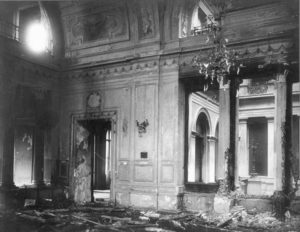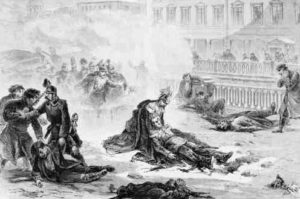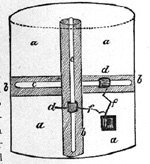I have been promising for some time a blog post about the 1881 assassination of the Tsar by suicide bomber in St Petersburg, the site of which I visited a few month ago. I think that this incident is particularly interesting for the following reasons:
- It was a suicide bombing by any definition and thus invites comparisons with modern suicide terrorism
- It seems to have sparked and inspired the revolutionaries of the time, demonstrating what was possible – for the next 25 years revolutionaries around the world sought to repeat the impact of the incident
- The design was enabled by the development of dynamite in the late 1860s and it would appear by Russian military experience of fusing from the sea mines I discussed last week
The late 1870s and early 1880s were politically a time of great drama. In Russia Anarchists and Nihilists were active and some sought the use of violence to achieve their goals in the light of poor harvests and industrial recession. The Nihilists objected to the status quo of the ruling class and the capitalist control of the economy and in that at least there are some very modern echoes. One particular group, the Narodnaya Volya (The People’s Will) decided to target the Tsar. One of this group’s early attempts to assassinate the Tsar was in Moscow in 1879 – the terrorists dug a tunnel from a house and planted three large command initiated IEDs under the railway on a track (by digging a tunnel under a road from a nearby house) that the Tsar was predicted to use. The attack failed as did an attempt a year later when explosives were planted in the Winter Palace in St Petersburg by an employee Stephan Khalturin who was able smuggle the explosives in bit by bit. The picture below shoes the aftermath.

I can’t find details of the construct of this device but I believe it was a timed IED. The Tsar delayed a reception dinner thus missing the explosion, but many people were killed or badly wounded in the incident. Amongst the dead were all the members of the Finnish Guard in a room below the intended victims.
In an early example of an “attack the Network” C-IED effort the Russian secret police, the Okrhana, was established in the light of the failed bomb attacks (along with the rise of left wing revolutionary groups) and they were the archetypal “secret police”, running double agents, agents provocateurs, surveillance and interception of communications. They also operated internationally.
On the 13 March the Tsar once again overruled the advice of his security staff and took his carriage on a well known and predictable route through St Petersburg from Michaelovsky Palace to the Winter Palace. Once again this is a story of terrorists exploiting the known and predictable routes of their target. An armed Cossack sat with the coach-driver and another six Cossacks followed on horseback. Behind them came a group of police officers in sledges.
All along the route he was watched by members of Narodnaya Volya, who had carefully planned a triple IED attack. On a street corner near the Catherine Canal a woman terrorist gave the signal to two of the conspirators to throw their bombs at the Tsar’s carriage. The bombs missed the carriage and instead landed amongst the Cossacks. The Tsar was unhurt but insisted on getting out of the carriage to check the condition of the injured men. While he was standing with the wounded Cossacks another terrorist, Elnikoff, stepped forward with a shout and threw his bomb on the ground between himself and the Tsar.

Alexander was mortally wounded and the explosion was so great that Elnikoff also died from the bomb blast. The device used is quite interesting – he is a contemporary description and an image.

The infernal machine used by Elnikoff was about 7 1/2, inches in height. Metal tubes (bb) filled with chlorate of potash, and enclosing glass tubes (cc) filled with sulphuric acid (commonly called oil of vitriol), intersect the cylinder. Around the glass tubes are rings of iron (dd) closely attached as weights. The construction is such that, no matter how the bomb falls, one of the glass tubes is sure to break. The chlorate of potash in that case, combining with the sulphuric acid, ignites at once, and the flames communicate over the fuse (ff) with the piston (c), filled with fulminate of silver. The concussion thus caused explodes the dynamite or “black jelly” (a) with which the cylinder is closely packed.
You will note some similarities, in principle, with parts of the initiating system from the Russian sea mines of the Crimean war that I posted last week.
In all, I think that this terrorist attack is one of the most significant in history – the first “suicide bombing” to gain international attention, and certainly an attack that inspired revolutionaries the world over. My friend Greg Woolgar, who is about to publish a much needed book on the Victorian Bomb disposal expert and first proponent of IED exploitation and technical intelligence, Colonel Majendie, tells me that the good colonel visited St Petersburg in the aftermath to seek intelligence on the device.
